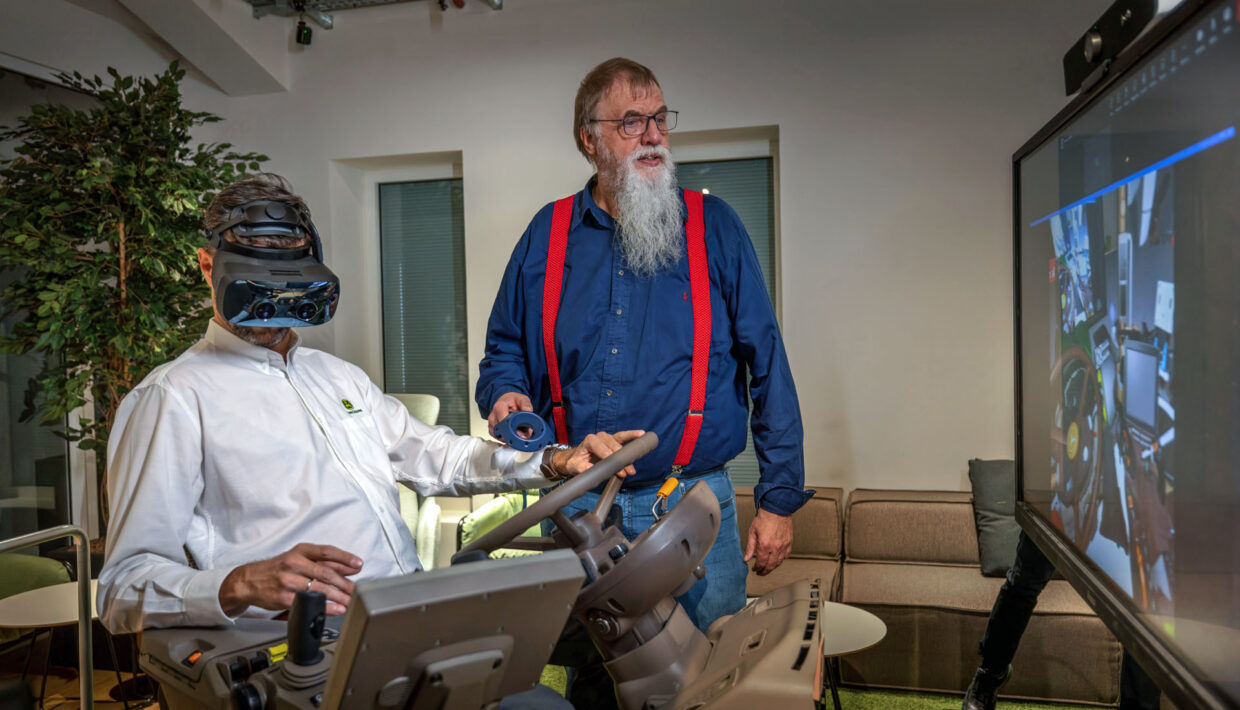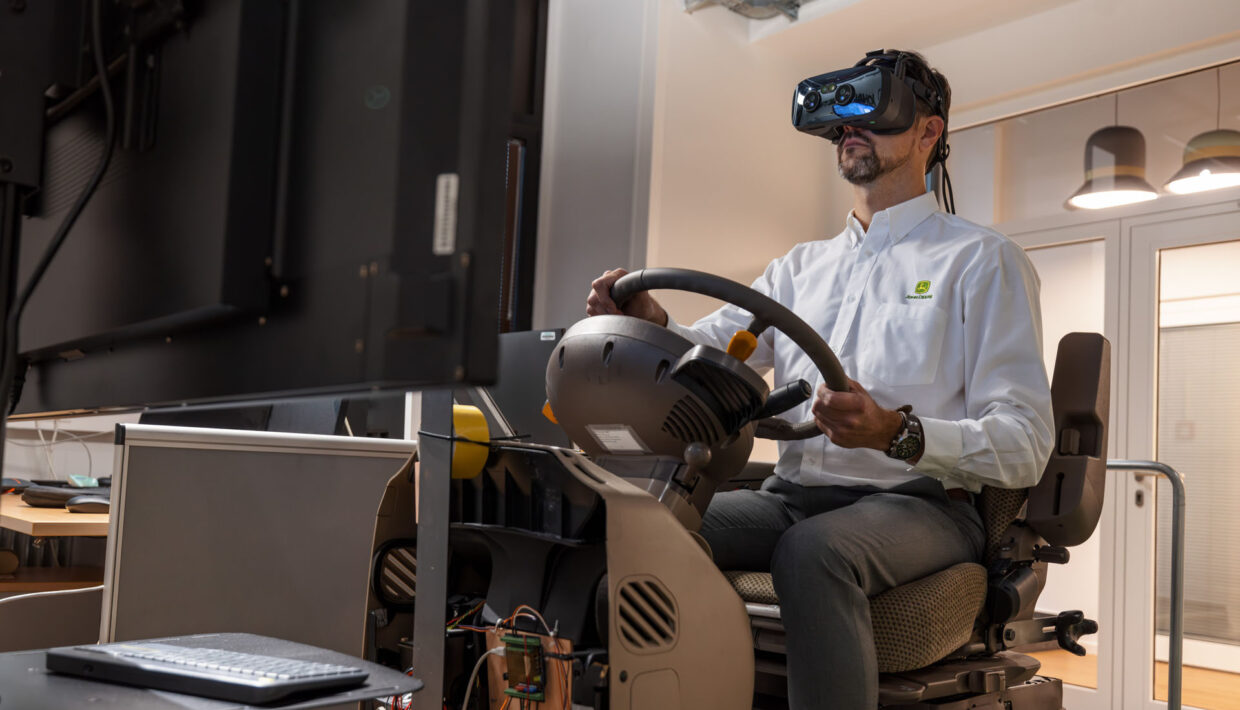Two desks, a seating area, a tractor seat with an operation unit, two pairs of 3D glasses and a couple of powerful computers – the office used by Jan-Gerd Hinrichs, who is responsible for product development virtual support at John Deere, may seem unremarkable at first glance. But this is not surprising, since the real magic happens in the virtual space, but the whole environment changes when the visitor gets into the tractor seat and puts on the virtual reality headset 3D glasses.
Suddenly, the visitor is no longer in an office in Mannheim, but in the cab of a 6R. Instead of looking at a grey office wall, the view now sweeps over the true-to-life digital representation of all the controls that exist in a physical tractor cab.
Virtual testing for real use
Jan-Gerd explains: “We use digital technologies like virtual reality and augmented reality to simulate, rebuild and optimise everything about the tractor without having to screw in a single bolt or install any hydraulic lines.” With the help of the tractor seat, he and colleagues from the design department are currently looking for the optimal mudguard shape for a new tractor series. They are particularly focusing on maximising the field of vision so that the driver can keep an eye on all important operations.
If you turn around in the seat in Jan-Gerd’s office, you can actually see what’s happening behind the tractor and its various implements, depending on the setting. “If we simulate a mudguard that blocks the visibility of an important area on an implement today, we’ll be experimenting with a different shape just a few days later – that doesn’t happen nearly as quickly with real prototypes.”
Jan-Gerd and his team can also test operating elements and innovations on the tractor control system this way; made possible thanks to augmented reality. “This is a mix of virtual reality and objects that actually exist,” says Jan-Gerd. “With our latest glasses, for example, we can extrapolate the hand in front of the tester’s eyes from the projected reality. This way, the user sees the virtual world and their own hand at the same time. So, they can now realistically determine how well they can access individual cab operating elements.”
In this way, John Deere not only tests new concepts internally, but also with customers. They can provide feedback early in the development process on which ideas work well and where improvements should be made – before a single real part is produced.
A tractor in the office
Just across the hall, opposite Jan-Gerd’s office, is the CAVE: Computer Aided Virtual Environment. This room also appears unremarkable at first: There are two tables, a powerful computer, a rack holding about 20 pairs of 3D glasses, and eight small beams on the ceiling, all pointing to one corner. But when Jan-Gerd and his visitors put on their 3D glasses and turn on the projector, a green and yellow tractor suddenly appears in front of them – as tall as a man and three dimensional.
This virtual model is what the experts refer to as the “digital build” of the tractor. The data for the model comes from all departments involved in tractor construction. The tractor depicted here is completely digital: From the engine to the frame, to the last hydraulic hose and the smallest screw. “We have now used these kinds of builds for over 100 tractor models,” says Jan-Gerd. “They allow engineers and designers to look at a tractor in every possible configuration and see where there might be problems before the first real prototypes are built.” On average, the team looks at between 20 and 30 configurations per tractor.

See more on the 3D model
Of course, you could also look at this kind of digital model on a 17-inch monitor at a regular office workstation, but the developers and designers still appreciate working together in the CAVE “Here, colleagues can discuss things on one model and everyone sees the same thing at the same time. In addition, we can cut through the tractor in this room at any point and investigate its furthest corners to see if there might be problems – like with the cabling, for example.” As Jan-Gerd explains this, he moves a small control unit in his hand around the room, using it to turn the tractor, zoom in and out, and cut through the model at different levels.
We can cut through the tractor in this room at any point and investigate its furthest corners to see if there might be any challanges, for example with the wiring.
Jan-Gerd Hinrichs
So, what is the technology behind this magic? “We make use of various software solutions,” says Jan-Gerd. “Most of them can do about 80% of what we need. We then program the rest ourselves.” A more popular solution is the Unity game engine, which is used to build complex computer games and simulations. Jan-Gerd’s team uses it to view the detailed cabs and tractors.
The team like to think outside the box, so they can support colleagues from other departments. “For example, our equipment was used when a new test rig was to be built in an existing workshop here in Mannheim,” says Jan-Gerd. “We simply took all the technology there and used it to beam the test rig with its actual dimensions into the room. This allowed everyone involved to see how it would fit on the existing floor space and if and how overhead cranes could be used to set up the test rig.” This is just another demonstration of the real-world benefits that virtual worlds bring to John Deere.




